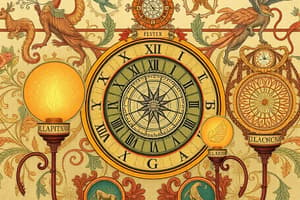Podcast
Questions and Answers
Relaciona las siguientes magnitudes fundamentales con sus respectivas unidades de medida:
Relaciona las siguientes magnitudes fundamentales con sus respectivas unidades de medida:
Longitud = metro (m) Masa = kilogramo (kg) Tiempo = segundo (s) Intensidad de corriente = amperio (A)
Empareja las magnitudes derivadas con sus unidades correspondientes:
Empareja las magnitudes derivadas con sus unidades correspondientes:
Velocidad = metro por segundo (m/s) Densidad = kilogramo por metro cúbico (kg/m³)
Vincula los tipos de magnitudes con ejemplos específicos:
Vincula los tipos de magnitudes con ejemplos específicos:
Vectoriales = fuerza, desplazamiento, aceleración Escalares = volumen, área, energía
Asocia las unidades de longitud con su respectiva conversión:
Asocia las unidades de longitud con su respectiva conversión:
Relaciona los ejemplos de transformación de unidades con el resultado correcto:
Relaciona los ejemplos de transformación de unidades con el resultado correcto:
Empareja las magnitudes fundamentales con su respectiva cantidad de sustancia química:
Empareja las magnitudes fundamentales con su respectiva cantidad de sustancia química:
Flashcards are hidden until you start studying
Study Notes
- Fundamentals physical magnitudes include length, mass, time, electric current intensity, temperature, light intensity, and amount of chemical substance.
- Units of measurement for these fundamental magnitudes: length in meters (m), mass in kilograms (kg), time in seconds (s), electric current in amperes (A), temperature in kelvin (K), light intensity in candela (cd), and amount of substance in moles (mol).
- Derived magnitudes include velocity (m/s) and density (kg/m³).
- Standard units for length are the meter, with additional units like kilometer, hectometer, decameter, decimeter, centimeter, and millimeter.
- The utility of these relationships lies in the ability to convert between units, for example, from kilometers to meters or vice versa.
- Transformation examples: 4 kilometers to meters = 4,000 meters, 8,500 meters to kilometers = 85 kilometers.
- There are scalar and vector magnitudes. Vector magnitudes have magnitude, direction, and sense (e.g., displacement, velocity, acceleration).
- Scalar magnitudes include distance, mass, volume, area, temperature, pressure, energy, time, density, and frequency.
- Scalars are represented by a single value and do not require direction or sense.
Studying That Suits You
Use AI to generate personalized quizzes and flashcards to suit your learning preferences.




